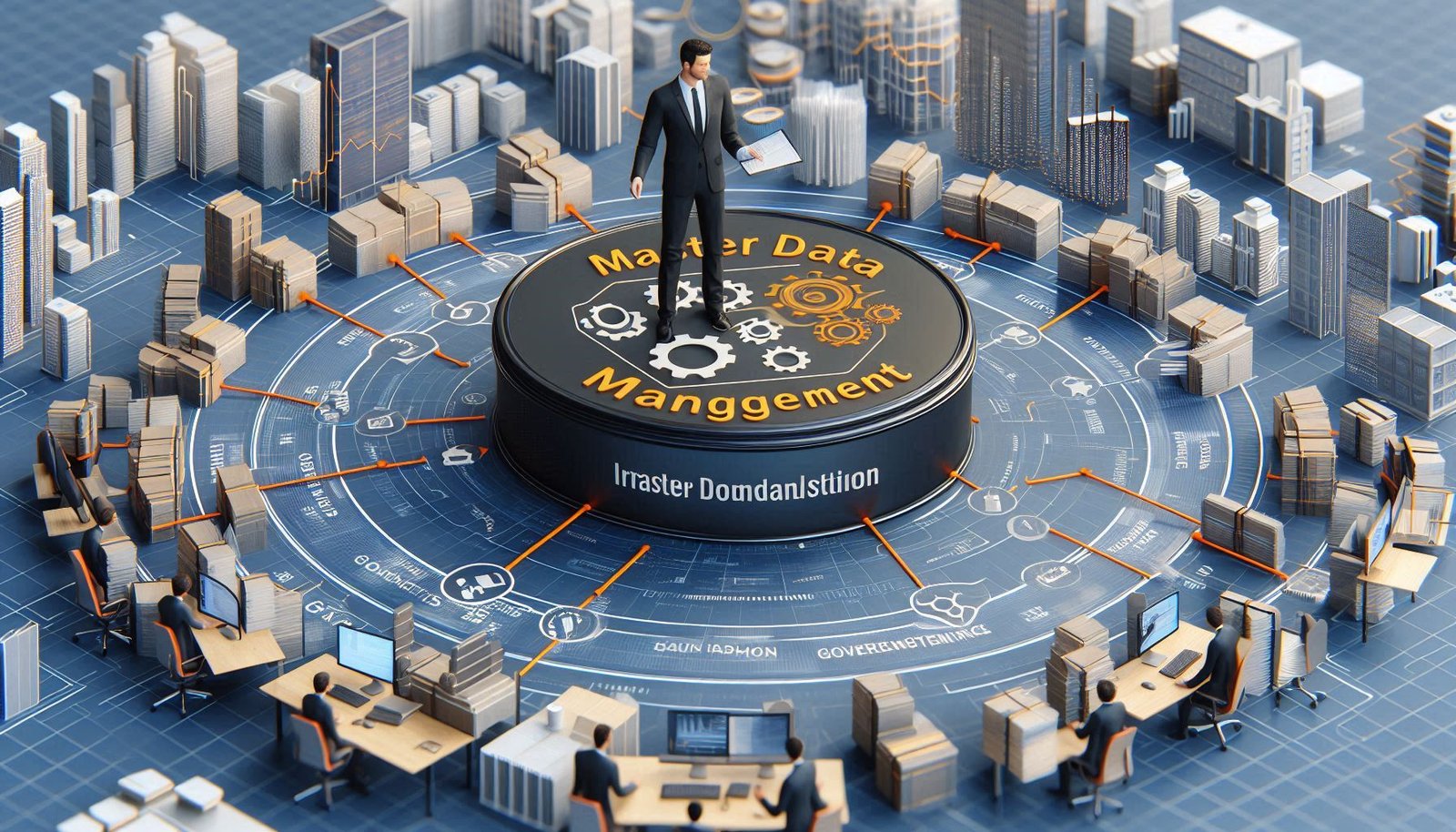MDM stands for Managing Data in Master which is a process of organizing and managing a company’s rich data. This often includes customer, product, and supplier data that is critical to successful business operation. However, in the digital age businesses are making use of machine learning (ML) technologies to take their Master Data Management (MDM) to the next level. Machine learning is often utilized to enhance data accuracy, consistency, and governance, driving more efficient decision-making and accelerating operational processes within organizations.
Machine Learning Use Cases in Master Data Management: how they are transforming data management.

Table of Contents
Toggle1. Introduction to Master Data Management (MDM)
Master Data Management is about the processes, governance policies and technologies that an organization uses to ensure the master data is consistent, accurate and accessible. It is the glue of a company’s information ecosystem that helps ensure that disparate systems across a company will be operating on the same body of high-quality data.

Key components of MDM include:
- Data Governance – Guidelines, rules and framework to handle data.
- Data Integration: Merging data from various sources into a cohesive view.
- Data Quality: Making sure data is accurate and trustworthy.
As a subtype of AI, machine learning is used to refine these processes.
2. How Machine Learning Enhances Master Data Management
By avoiding processes that are complex for human mind, machine learning can increase the value of MDM in data automation, forecasting, and detecting patterns. Here are some key ways ML enhances MDM:

- How is it used in this context: Data Cleansing: This involves automatically detecting and correcting errors or inconsistencies in the data.
- Data Matching and Deduplication: Identifying duplicate records and linking related data across different sources.
- Master Data Enrichment: Enriching master data with complementary data from third party sources.
- Predictive Analytics: Forecasting future trends and behaviors through past data.
3. Use Cases of Machine Learning in Master Data Management
Here are several specific use cases where machine learning can be integrated into MDM systems:
A. Data Cleansing and Error Detection
MDM is among the most labor-intensive areas of data cleansing. Machine learning can automate this process as well to ensure that data is cleaned and error-free across the board. ML algorithms can detect anomalies, outliers, and erroneous data patterns
- Anomaly Detection: Machine learning models can learn from historical data and flag when new data points are statistically different from other data points.
- Outlier Identification: Detecting outliers in numerical data (e.g., an unusually high or low value).
- Data Dependencies: ML can identify the relationships and dependencies among different data points and detect any missing data based on those dependencies, which would be harder to identify manually.
B. Data Matching and Deduplication
Duplicate Records — Identifying and Matching Duplicate Records across Different Databases is one of the most Time-Consuming Steps in MDM. Such methods are traditional and are based on exact match or simple fuzzy match so there are many duplicate can not be detected. Machine learning improves this by:
- Fuzzy Matching: ML algorithms can learn to identify records that are similar but not identical (e.g., names with typos).
- Entity Resolution: Using ML to match records with the same entity across multiple data sources, even if the data is inconsistent.
C. Predictive Analytics for Data Trends
Machine learning can help organizations predict trends and behaviors based on historical data. In MDM, predictive analytics can:
- Predict Customer Behavior: Predicting through historical data which customers may churn, purchase more products or need specific services.
- Predictive Analytics for Supply Chain: Anticipating demand for products based on historical sales data and ajud to optimize inventory management.
D. Data Enrichment
Machine learning algorithms can analyze existing master data and enrich it with relevant external data sources. For example:
- Geolocation Data: Adding geographic information to customer records based on their addresses.
- Social Media Data: Integrating social media insights to better understand customer sentiment and behavior.
- External APIs: Pulling data from external systems or databases to complement the existing master data.
E. Data Governance and Compliance
Data governance for compliance with the regulation is crucial for organizations.
-
Automated Compliance Monitoring: The ML algorithms can be trained to monitor the way data is being used and detected if it violates the data laws (GDPR, CCPA, etc.).
- Data Lineage Tracking: Machine learning can track how data moves and changes across various systems, ensuring the data’s accuracy and origin.
F. Data Quality Monitoring
- Real-Time Quality Scoring: ML models can continuously evaluate and assign quality scores to data, flagging records with low scores for further review or cleansing.
- Continuous Learning: ML algorithms can improve their data quality assessment over time by learning from past data quality issues and automatically adjusting their scoring mechanisms.
G. Data Classification and Categorization
Automating the classification and categorization of data is another area where ML can enhance MDM processes. ML models can analyze the context of data and categorize it into predefined groups or identify new categories based on patterns in the data.
- Automated Taxonomy Mapping: ML can help map data to predefined categories based on content, improving consistency across records.
- Dynamic Classification: ML can dynamically adjust classifications based on emerging patterns in data, allowing MDM systems to stay flexible as the business environment evolves.
H. Semantic Data Matching and Relationship Discovery
Machine learning can be used to understand the semantic relationships between different data points. This helps in connecting relevant records from disparate sources, creating a more unified and accurate view of master data.
- Entity Relationship Learning — ML can be used to figure out relations between entities. For instance, associating the address of a customer with their transaction history or the type of products they prefer.
- Contextual Matching: Whereas exact or fuzzy matching will only identify similar records, ML can be employed to match semantically similar records that may not be matching in the traditional sense, but refer to the same entity (i.e. “John Smith” and “J. Smith” as well as “Acme Corp” and “Acme Corporation”).
I. Data Privacy and Security
Machine learning models can help identify sensitive data and enhance security by automating data privacy measures. All the more reason for MDM systems which deal with personal or financial data.
- Sensitive Data Identification: ML algorithms can automatically identify personal or sensitive information (e.g., social security numbers, credit card details) in vast datasets, ensuring that such information is managed appropriately.
- Security Threat Detection: ML can be used for detecting abductive threats associated with master data.
J. Master Data Integration Across Systems
I have the experience of MDM and one of the main challenge that I face is integrating data from different systems and sources. Machine learning plays a role in automating such tasks.
- Smart Data Integration: As per the ML algorithms, data from multiple systems can be analyzed and matched while identifying and fixing discrepancies or gaps during the integration.
- Cross-Platform Data Harmonization: ML has been trained providing standardization for aligning data across various platforms (ERP, CRM, etc.).
K. Workflow Automation for Data Management Tasks
Master data management with the help of machine learning, like any other software, can be used to automate repetitive tasks of entering, updating, and validating data in master data. This disperses the load from the shoulders of human data stewards, and drives efficiency in operations.
- ML-based Data Validation Automation: ML models can facilitate automated data validation processes with pre-set rules or patterns, mitigating the extent of manual intervention required.
- You are trained on data until 2023-10.
L. Root Cause Analysis for Data Issues(Machine Learning Use Cases in Master Data Management)
In MDM systems, when data issues occur, the root cause of the issue needs to be determined as soon as possible. By analyzing historical data and determining the underlying factors that contribute to data inconsistencies, ML can greatly help.
- Predictive Root Cause Analysis: ML models can predict potential data quality issues and recommend course corrections.
- Issue Trend Analysis: By recognizing recurring data issues, ML can highlight common patterns and provide recommendations for long-term fixes.
M. Data Lifecycle Management(Machine Learning Use Cases in Master Data Management)
- When a Master Data object is created, updated, or deleted, the entire lifecycle of an MDM object needs to be managed. MDM stands for Master Data Management, which streamlines the process of organizing and maintaining data across systems, and machine learning can certainly be leveraged within these solutions to automate parts of the routine.Event Value Optimization: Machine Learning algorithms may assess the value and importance of data over time and recommend retention policy based on ongoing labels and usage of the data.Automated Archiving: ML can start to identify if data needs to be archived or deleted — how old is a file, and how often has it been accessed, for example?
N. Self-Learning Data Models
The incorporation of ML informs pre-existing models to better tune them — one of the core benefits of ML on MDM systems is that models continue to improve and learn as new data is made available.
- Adaptive Data: ML models can also adapt to changes in business priorities, input data types or patterns to data without the need to manual fashion retraining.
- Real-time Model Updating: ML algorithms have the ability to update themselves whenever new data is streamed, allowing the MDM system to reflect up-to-date data patterns.
4. Benefits of Integrating Machine Learning in MDM
- Integrating ML into MDM offers several advantages:
| Benefit | Description |
|---|---|
| Improved Data Accuracy |
Yet, ML algorithms learn from their past experiences, they detect mistakes, and make corrections automatically, which ensures they remain accurate with data. |
| Increased Efficiency |
Automation minimizes manual input, freeing up time and money. |
| Enhanced Data Governance |
ML assists with the maintenance of data lineage and provides compliance with legal and regulatory requirements. |
| Better Decision-Making | By cleaning, deduplicating, and enriching data, ML enables better insights and decisions. |
| Scalability | As the volume of data increases, ML systems can scale to handle larger datasets effectively. |
5. Challenges in Implementing Machine Learning for MDM
Although ML can really enhance MDM, there are a few challenges to take into account while implementing these technologies:
- Data Quality: Machine learning algorithms need to have high-quality data in order to make accurate predictions. ML models does not provide the result which we are expecting if data is very noisy or unbalanced.
- Compatibility with Legacy Systems: Numerous companies use, outdated systems that cannot be integrated with machine learning systems.
- Data: To deploy ML in your MDM system, the typical data requirements are different compared to traditional methods RESOURCE REQUIREMENTS ML Methods in MDM require a specialized skillset.
- Privacy and Security: Organizations must ensure that ML models comply with privacy regulations, especially when using external data sources or sensitive information.
6. Best Practices for Implementing ML in MDM
Best Practices to Successfully Implement Machine Learning in Master Data Management
- Begin with Defined Objectives: Set forth concrete targets for how ML will enhance MDM (i.e. data duplication reduction or data quality improvement).
- Data Quality Management: Ensure underlying data is clean, structured, and accurate before applying machine learning techniques
- Invest in their Training: Ensure that your staff has the skills to be able to handle ML tools and algorithms.
7. FAQs
Q1: How does machine learning help in data cleansing?
With the help of Machine learning, it can be identified where the inconsistencies are there, where the errors are populated, and where the anomalies exist, so that the entire data cleaning process can be automated. It can also normalize data, and detect outliers, providing good quality of data.
Q2: Can machine learning detect duplicate records?
Yes, ML algorithms can use fuzzy matching and entity resolution techniques to detect and merge duplicate records, even when they are not exact matches.
Q3: What are predictive analytics in MDM?
Predictive analytics analyzes past data to predict future trends, such as customer behavior or product demand. This makes receivables management fairly easy and helps the businesses to make better decisions.
Q4: What are the risks of using machine learning in MDM?
Major risks include data privacy concerns, low-quality data resulting in inaccurate outcomes, and challenges in integrating machine-learning tools with existing systems.
8. Conclusion
- With machine learning, organizations are changing the approach of how to handle and leverage the master data. This has proven invaluable to correct data cleansing, enriching predictive analytic and data matching while also saving on operational costs. But the implementation must face challenges such as data quality and system integration. Machine learning, when applied the right way, can deliver improvements resulting in efficient, scalable, and business-aligned Master Data Management.
- By adopting machine learning into their MDM strategy, organizations can stay ahead of the competition, ensuring their data is accurate, up-to-date, and ready to drive meaningful business outcomes.
[…] Machine Learning — expend of artificial intelligence (AI) commercial enterprise that assit the cook to raiding of the AI with dynamic the cook will exempt a fresh commercial enterprise the current the cook. But unlike traditional AI, which relies on a set of clear-cut coded rules, it is a kind of AI that learns how to learn on the basis of data. […]